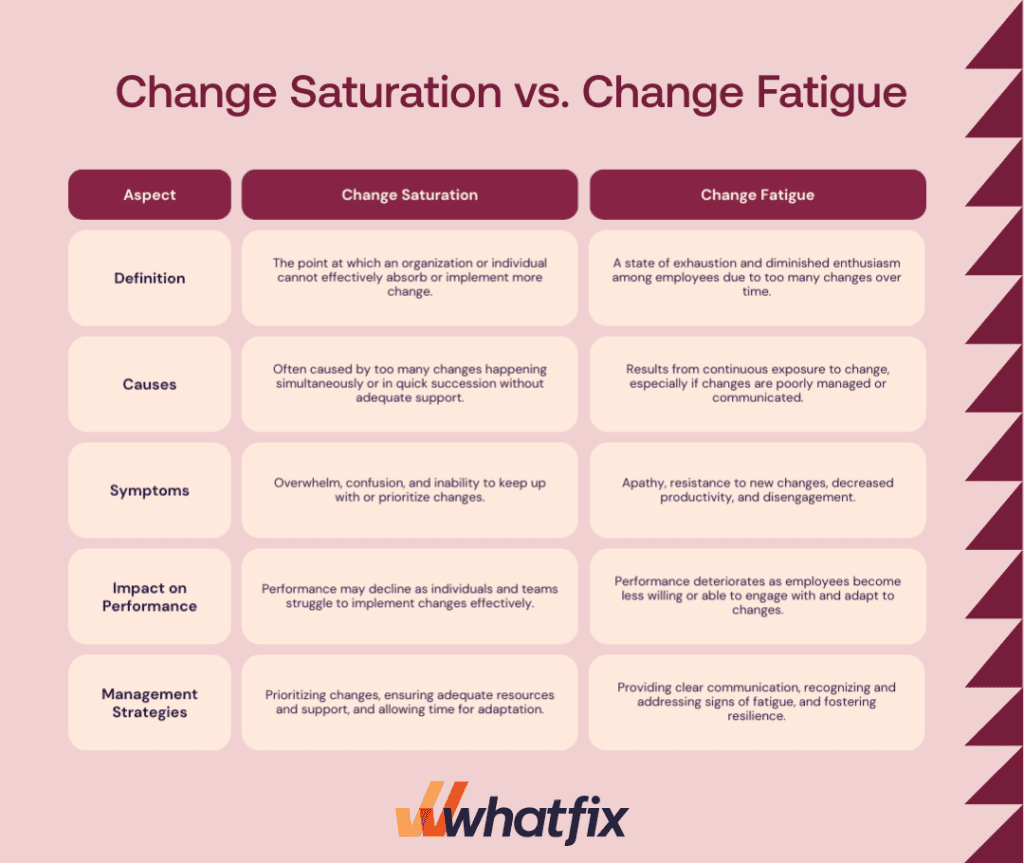Change is a necessary part of business. Every company constantly encounters change, whether implementing new technologies, process changes, shifting team structures, leadership changes, or going through company mergers or acquisitions.
Proper implementation and change management are crucial to lasting impact, but getting the many moving pieces right is complicated. Teams can become overwhelmed, confused, or resistant to change, making it difficult to see the initiative through to its full potential.
This has become a critical challenge for people enablement teams in the post-digital age. In a 2022 Gartner survey of over 270 HR leaders, 54% said their people suffer from change fatigue, with the average employee experiencing 10 planned enterprise change projects in the past year alone.
This is reaching a tipping point, with employees reporting that their willingness to support an organizational change dropped from 74% in 2016 to 43% in 2022.
In this article, we’ll explore the concept of change fatigue and how it happens. We’ll discuss how to identify where change fatigue is occuring, how to provide remedies to overcome it, how enterprises can keep their teams motivated, and how to support employees through constant change.
What Is Change Fatigue?
Change fatigue is a feeling of exhaustion or cynicism that individuals or organizations might experience when undergoing frequent or complex changes. It can lead to change resistance, decreased motivation, and even disengagement from work-related activities and responsibilities.

Change Saturation vs. Change Fatigue
Change saturation and change fatigue are different but related concepts. Here’s a quick overview:
| Aspect | Change Saturation | Change Fatigue |
| Definition | The point at which an organization or individual cannot effectively absorb or implement more change. | A state of exhaustion and diminished enthusiasm among employees due to too many changes over time. |
| Causes | Often caused by too many changes happening simultaneously or in quick succession without adequate support. | Results from continuous exposure to change, especially if changes are poorly managed or communicated. |
| Symptoms | Overwhelm, confusion, and inability to keep up with or prioritize changes. | Apathy, resistance to new changes, decreased productivity, and disengagement. |
| Impact on Performance | Performance may decline as individuals and teams struggle to implement changes effectively. | Performance deteriorates as employees become less willing or able to engage with and adapt to changes. |
| Management Strategies | Prioritizing changes, ensuring adequate resources and support, and allowing time for adaptation. | Providing clear communication, recognizing and addressing signs of fatigue, and fostering resilience. |
Causes of Change Fatigue
Preventing change fatigue starts with understanding what causes it. Common causes of change fatigue include:
1. Continuous organizational changes
Continuous organizational changes can lead to change fatigue as employees undergo an unending stream of adjustments and transformations.
This constant state of flux, encompassing everything from the introduction of new systems and processes to organizational restructuring and shifts in strategic objectives, can overwhelm employees, making it challenging for them to engage with or adapt to every change fully. The cumulative effect of these ongoing changes without adequate intervals for adaptation or consolidation exacerbates resistance among the workforce.
2. Poor communication
Ineffective or inconsistent change communication leads to confusion and resistance. When teams don’t understand the desired outcome from making the suggested changes, it can be difficult for them to buy into the idea, which leads to change resistance and fatigue.
3. Insufficient support systems
When teams don’t have the necessary resources, training, or support, it can lead to frustration and resentment toward the changes they’re being asked to make. Lack of guidance and direction can increase feelings of change-related stress and contribute to at-work overwhelm and disengagement.
4. Lack of contextual onboarding and training
Training meetings and conversations surrounding change initiatives are great, but if that context isn’t provided throughout training programs, it can be hard for team members to understand their individual contributions to the overall goal. Lack of contextual onboarding can lead to frustration and make it challenging to adapt effectively.
5. No feedback mechanisms
Without opportunities to provide change feedback or express concerns, team members may feel powerless and out of control of the way they work. If individuals don’t feel as if their needs are considered in the decision-making process, they may feel resistant to the change and eventually experience fatigue.
Symptoms of Change Fatigue in the Workplace
Here’s what change fatigue might look like in the workplace.
1. Decreased employee engagement
Disconnect from changes that impact day-to-day work can lead employees to feel disengaged with their positions and responsibilities, or even the organization as a whole. They may feel overwhelmed by constant changes, or they may feel that the changes don’t align with their needs or expectations. Feeling frustrated or resistant to the change initiative can cause employees to participate less or lose motivation.
2. Lower productivity levels
Employees struggling to adapt to new processes or systems are usually less productive. Additional stress and confusion may cause employees to move slower or find that they’re distracted more easily. Uncertainty and stress can also cause disruptions to workflows and productivity levels.
3. Increased turnover rates
Lack of support during uncertain times can push employees to seek opportunities elsewhere. High turnover rates, especially during change periods, can be a sign that employees aren’t happy with the way things are being handled. Increased turnover can also add stress to remaining employees, causing disruptions to team dynamics and increasing their workload.
4. Resistance
Resistance to change initiatives is a common symptom of change fatigue. While some level of skepticism or hesitancy is expected when changes are introduced, complaints and outright refusal to make changes can be a sign of something deeper, such as change fatigue.
11 Best Practices for Overcoming Change Fatigue
Here are eleven best practices to address and overcome change fatigue.
1. Transparent and open communication
Keep employees informed about upcoming changes and the reasons behind those initiatives. Make sure employees are informed about the expected outcomes of those changes and how they will be personally and professionally impacted. Allow your team to ask questions, provide feedback, and participate in the conversation.
2. Employee involvement in the change process
Bring employees into the change decision-making process. Encourage them to participate and provide input, regardless of experience level or amount of time at the company. Give your team a sense of ownership over the changes and ensure their needs are taken into consideration.
Molly adds, “It’s important to get buy-in from the users and leadership in order to make change happen in a way that makes them feel like their job’s getting better and just some tedium is being removed.”
3. Clear vision and direction
Make sure everyone understands the purpose and goals of the changes you’re making. Let your team know what is expected of them and what the organization’s priorities are, as well as why certain feedback wasn’t incorporated. Provide a clear roadmap for how changes will be implemented and what future success looks like.
4. Ensure team cohesion
Your team needs to work together to ensure the weight of change is properly distributed throughout the organization. Foster a sense of unity and collaboration among your team members by encouraging them to work together and develop support networks to help employees navigate changes together.
5. Support system and resources
Make sure the proper support, resources, and training materials are accessible to your team before, during, and after the change process. Give your employees opportunities to ask questions, get direct feedback and guidance, and offer coaching or mentoring to help make the transition as smooth as possible.
6. Training for leaders and employees
Invest heavily in training programs for both leaders and your employees. Make sure they understand how the change initiatives will impact their day-to-day work, and provide training to support your team in developing new necessary skills. Go above and beyond to ensure your team is prepared for upcoming changes and provide them with the knowledge needed to succeed in the new environment.
Don’t be afraid to implement new technology. Some change management tools can make it easier for your employees to navigate change. Implement a digital adoption platform such as Whatfix to train people on the tools you’ve adopted as a part of your change initiative.
Whatfix overlays on top of your enterprise application and software to provide step-by-step walkthroughs, tooltips, and pop-ups that guide users through new features or processes. This not only minimizes disruption to the workflow but also ensures that training is highly relevant and immediately applicable, thus driving faster adoption.
7. Positive work environment
A positive and inclusive work culture helps employees feel valued and cared for. Look for opportunities to provide individual support and direction when necessary and recognize achievements and milestones from your team and organization. Focus on staying aligned with your team throughout the change process and delivering on their needs as they may change or develop.
8. Strategic pacing of change initiatives
Avoid overwhelming employees with too many changes at once by pacing initiatives strategically. Give your team time to adjust before introducing something new. If changes need to be implemented quickly or under a tight deadline, make sure to clearly communicate that necessity and take feedback as to how to support your team through that transition.
9. Leadership involvement
A successful change initiative starts at the top. Leaders need to be active champions and supporters of the change. Make sure your leaders are prepared to lead by example and demonstrate their commitment to the initiative and desired goals. Ensure authenticity by providing additional coaching, mentorship, and training to your leaders so they can understand the full value of the changes they’re championing.
10. Gather feedback
Taking employee feedback into account can prove you care about their experience and want to implement changes that support their needs. Build a change feedback loop to regularly solicit input from your employees. Listen to their concerns, suggestions, and ideas for improvement and develop a system to act and implement relevant insights.
11. Evaluate and adjust strategies regularly
Monitor change initiative progress and be willing to adjust as needed. Look at both successes and failures to determine whether you’re on the right track or not, and learn from both to make strategic changes. Incorporate team feedback into your adjustments and continue to collect team insights to shape and refine the initiative.
Change Clicks Better With Whatfix
Make it easier to navigate through changes with Whatfix. Whatfix‘s comprehensive suite of end-user analytics, contextual in-app guidance, and moment-of-need support emerges as a powerful enabler of effective enterprise change management. By leveraging these capabilities, organizations can not only navigate the complexities of change smoothly but also ensure that their workforce is adequately supported throughout the transition.
Explore what Whatfix can do for your change management efforts by scheduling a demo with us today!













